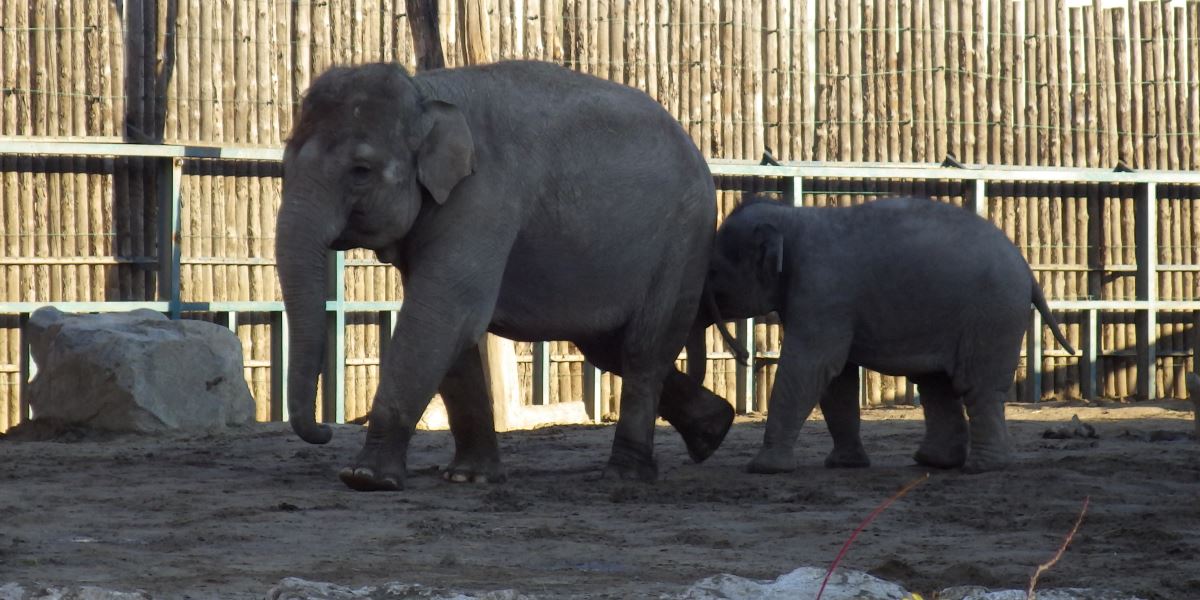The Asian elephant is one of the smartest animals in the world. Elephants are at least as smart as the great apes and in many respect their brain might be even better developed than most of the apes, except perhaps us humans. Apart from being smart an elephant also has great dexterity — an elephant can use its trunk the same way we use our hands.

An Asian elephant (Elephas maximus) mother with her calf in the Budapest Zoo.
When I visited these elephants were running around outside the elephant house in spite of the slightly chilly air.
Elephants do need to walk a lot so it is unlikely that they would be comfortable confined indoors. A lot of animal rights activist argue that a typical elephant exhibit in a zoo is just too small for the animals to be comfortable.
Besides being smart and skillful with their trunks, elephants show other traits typically only attributed to humans and perhaps the great apes. They are capable of a wide range of emotions such as grief and compassion. Elephants are also self-aware. Elephants do have a complex social life and individuals do develop relationships. There is some evidence that they do miss each other if separated and do show signs of happiness when they reunite with long lost relatives, not forgetting them even after decades.
The Asian elephant is often tamed and put to work, but nearly all these elephants are wild caught and forced into hard labor. Asian elephants are very rarely bred in captivity for work purposes so they aren’t really domestic animals.

Asian elephants (Elephas maximus) in the Veszprém Zoo. These elephants were in a huge display area indoors, inside a brand new building, where they were running around. Apparently a lot of money was spent to provide a suitable environment for them even during the winter.
Beside being forced to do hard labor using their great strength there is a growing industry where elephants are forced to paint childish pictures which are then sold to tourists as novelty art of some sort. Elephants do have very good coordination when handling a brush with their trunks but they are not expressing themselves creatively when painting pictures of elephants or pretty flowers, they are just reproducing drawings that were often beaten into them so they can perform for tourists.
As I have mentioned above on the other end the the spectrum some people want to ban even zoos from keeping captive elephants but as their habitat is destroyed and wild individuals are at risk of being captured and ‘forced into slavery’ — so to speak. Perhaps keeping breeding groups of elephants in zoos is a good insurance against some disaster that could wipe out the entire species.
Rather than banning zoos from keeping elephants outright they should be encouraged to provide proper facilities for them to live at some level of comfort. I do think the general public should be able to see live elephants otherwise people might cease to care what happens to them.

Asian Elephants outdoors in the Veszprém Zoo.
It is a lot more questionable if various private shows and circuses should be allowed to use elephants in their performances especially if the elephants are forced to perform unnatural acts and if they are kept under deplorable conditions.
Needless to say that you should not get an Asian elephant, or any elephant at all, as a pet, unless you own dozens if not hundreds of square miles of land in a suitably warm place where you can house an entire herd of elephants and have the resources to feed them and care for them.
Further Readings:
Asian Elephants – National Geographic.
WWF – Asian elephants.
Can elephants really paint? – Mother Nature Network.


